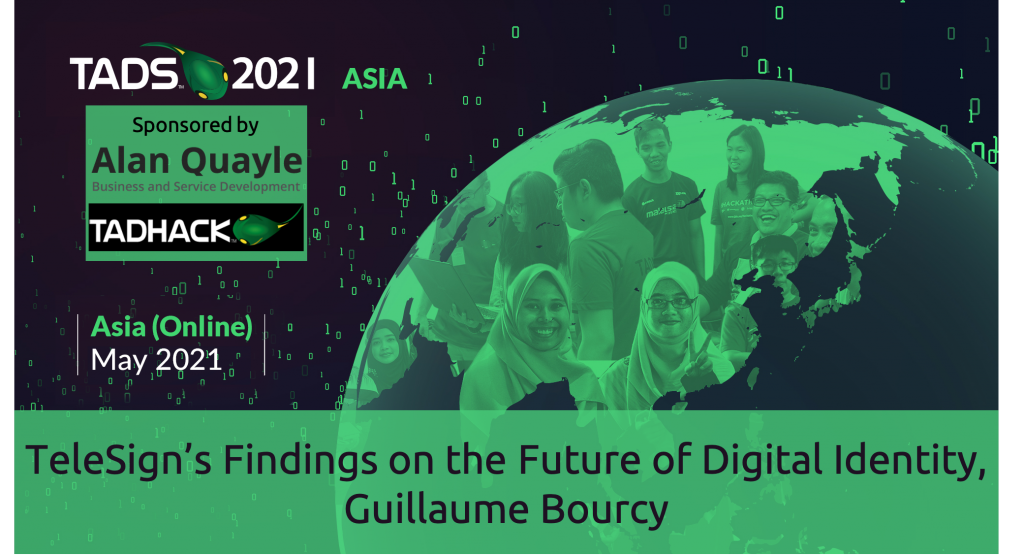Video and Slides
Outline: TeleSign’s Findings on the Future of Digital Identity
Guillaume Bourcy, Data Growth and Strategy at TeleSign
- COVID-19, A sign of What’s to Come: Accelerated Digital Transformation brings vulnerabilities, even with basic mitigation practice.
- How Fraud is Endemic: Shifting from offline to online increases the need to establish trusted digital identities in real-time.
- Today weaknesses, myth and reality of current solutions: Evolving government regulations have a serious impact on global industries.
- Mitigating friction, while adhering to regulation and enhanced security processes, can be challenging.
- Rising need for Ubiquity: A single, reliable partner to enable engagement and provide security insights.
Presentation Review
You can ask Guillaume questions in the comments section of this weblog, or contact him directly, his info is in the presentation.
This is an excellent review of digital identity, and also includes some fun scenes taking advantage of this online format.
Simply, digital identity is a merger of online and offline identities to give a 360 degree view of the customer. There’s a fun scene, where Guillaume is clearly drawing on all those war-time movies where an official demands to see your papers. And his son, never being exposed to that, produces quite a few different types of paper.
The pandemic has increased the importance of this unification given the 20% rise in ecommerce (people buying their shopping online), 400% rise in fraud attacks with 40% of them coming from and humans not just bots.
Merging online and offline identities is tough given the fragmentation, regulations, and the concern of fraud prevention impacting customer conversion. The myth that security and user experience are at odds.
This leads nicely into why TeleSign has been successful in digital identity because the phone number bridges both the offline and online identities. And can, as we’ve seen in previous TeleSign presentations at TADSummit, simultaneously improve customer experience and security.
Thank you Guillaume for an excellent review of digital identity, the important role TeleSign plays in merging offline and online identities. Plus some highly entertaining scenes, taking advantage of this online format 🙂


Thank you Guillaume for an excellent review of digital identity 🙂
1) Would you give some examples of how using the phone number simultaneously improves security and customer experience?
2) Does creating a unified identity create a ‘honeypot’ for criminals to target? Facebook has lots of offline information available online, and seems to annually have a data breach.
3) A data point that surprised me was 40% of fraud attacks are driven by humans. This shows there’s big money in fraud! How can unified identity help lower fraud and improve experience for human to human interactions.
4) The slide ” Today’s Disparate Defense Process” reminded me of Okta / Auth0 markitecture. Do you see TeleSign as complementary or competitive with Okta?
1. Would you give some examples of how using the phone number simultaneously improves security and customer experience?
A typical application of improving both security and customer experience is in a call center type of scenario, where the phone number is used as unique identifier of a user/caller.
After processing -in a matter of a few milliseconds- some verifications, the agent/CRM will be receiving strong signals on a phone number behavioral risk assessment parameters such as type of usage, velocity among carrier and enterprise networks, etc.. resulting in a global confidence score. Then, an agent can engage in total trust with the calling party and have a great deal of information pulled out without going through the hassle of asking many different [security] questions for example when activating a new ID/Loyalty/Credit card, paying benefits, etc.
This solution is definitely improving the confidence In operating any type of transaction for the call-center/brand while enabling a smooth experience for the end-user/caller. …
2. Does creating a unified identity create a ‘honeypot’ for criminals to target? Facebook has lots of offline information available online, and seems to annually have a data breach.
Any sizeable company out there dealing with data -most companies these days- is a target for scammers, hackers, nation state attacks – the key is to make sure you are processing your data in meaningful ways, with multiple levels of encryption and hashing methods. This is also why we are looking at the scoring model as a best intermediary between all these data so if intercepted, it limits some of the applications and usage bad actors can use out of it.
3) A data point that surprised me was 40% of fraud attacks are driven by humans. This shows there’s big money in fraud! How can unified identity help lower fraud and improve experience for human to human interactions.
Indeed this one is coming from Arkose Q3 2020 Fraud Report: Q1 2020 saw a barrage of bot attacks, which represented 74% of all attacks, whereas Q2 2020 saw the highest proportion of human-driven fraud recorded over the previous 12 months with 41% of attacks originating form sweatshops and other malicious humans. This number has definitely increased due to Covid, in a pre-covid era, bots had an hegemony on frauds and attacks, however over the past year friendly frauds, benefits frauds, synthetic IDs have been shifting the way we have to detect fraud patterns and work on our models
4) The slide ” Today’s Disparate Defense Process” reminded me of Okta / Auth0 markitecture. Do you see TeleSign as complementary or competitive with Okta?
We definitely see ourselves in a complementary way, where we can bring a whole new level of solutions based on dynamic risk assessments, not only providing the end mile for 2FA.